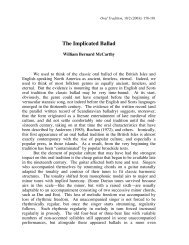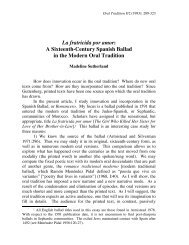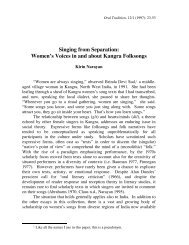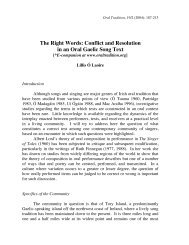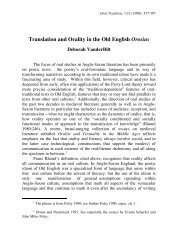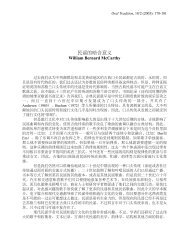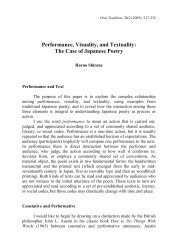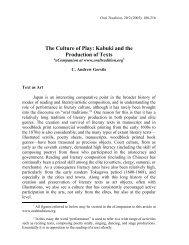Garner and Miller - Oral Tradition Journal
Garner and Miller - Oral Tradition Journal
Garner and Miller - Oral Tradition Journal
You also want an ePaper? Increase the reach of your titles
YUMPU automatically turns print PDFs into web optimized ePapers that Google loves.
356 LORI GARNER AND KAYLA MILLER<br />
work with this remedy 3 begun by James B. Spamer, who reminds us that “the original speakers<br />
of the charm were not Germanicists; they were beekeepers” (1978:280). Our work has also been<br />
heavily influenced by Marijane Osborn, who has thoroughly researched skep beekeeping<br />
practices as reflected across a broad range of medieval literatures <strong>and</strong> historical records in order<br />
“to open the way for further study” (2006:271, n.2). Our strategy here is to augment <strong>and</strong><br />
complement such prior work by going a step further <strong>and</strong> bringing knowledgeable <strong>and</strong><br />
experienced beekeepers directly into the discussion, sharing the text with them, inviting their<br />
reactions, <strong>and</strong> offering a more collaborative interpretation. That beekeeping (for purposes of<br />
honey <strong>and</strong> wax production) was an integral part of life in monasteries (Rust 1999) has been wellestablished<br />
<strong>and</strong> corroborates our view that the charm potentially had a vital practical role for<br />
those who had easiest access to the manuscript in which it survives. 4 Our ultimate goal is thus to<br />
shift our “default reading” of Wið Ymbe from its “artistic beauty of structure <strong>and</strong><br />
treatment” (Storms 1974:132) to one that embraces the “myriad other aspects of the given<br />
poem’s reality” (Foley 2002:60), namely its value within beekeeping practice.<br />
The two beekeepers participating in our project both have extensive experience in<br />
beekeeping. Chuck Crimmins, Gardening <strong>and</strong> Forest Coordinator at Heifer International in<br />
Perryville, Arkansas, has been educating visitors on bees <strong>and</strong> beekeeping since 1994. Richard<br />
Underhill, founding owner of Peace Bee Farm in Proctor, Arkansas, has served as president of<br />
both the Memphis Area Beekeepers Association <strong>and</strong> the Tennessee Beekeepers Association. We<br />
would like to establish from the outset that this comparative study presupposes neither that the<br />
practice of beekeeping is the same now as in Anglo-Saxon times nor that even the bees<br />
themselves would behave in exactly the same way. As Crimmins explains, bees in the United<br />
States have been bred for qualities that produce the best honey <strong>and</strong> present minimal threat to<br />
their h<strong>and</strong>lers. Similarly, materials used to work with bees have changed radically over<br />
intervening centuries, <strong>and</strong> there is obviously “a considerable difference between the hives of the<br />
Anglo-Saxons <strong>and</strong> modern hives, which is not inconsequential in our underst<strong>and</strong>ing of the<br />
charm” (Spamer 1978:280-81), the now-familiar white boxes of the modern Langstroth hive<br />
differing markedly from the traditional skep or basketwork hive most likely used by Anglo-<br />
Saxons (cf. Osborn 2005:7-9). 5<br />
In his comparative approach, John Foley’s work has always been intensely sensitive to<br />
cultural <strong>and</strong> generic difference at the same time that it is ever-open to insightful <strong>and</strong> meaningful<br />
3<br />
Because medical texts <strong>and</strong> classifications differed radically in Anglo-Saxon times from modern, the terms<br />
used to discuss these works are inherently problematic. We use remedy here as a broad category to refer to any text<br />
intended to effect a cure or positive outcome. The designations of charm <strong>and</strong> the native galdor (or gealdor) are<br />
limited to those particular texts involving verbal incantations. In the case of Wið Ymbe, the usages here are thus<br />
largely interchangeable.<br />
<br />
4<br />
On the richly powerful beekeeping metaphors employed in such religious writings as Aldhelm’s, see<br />
Casiday 2004.<br />
<br />
5<br />
Most relevant for present purposes, the Langstroth hive reduces, even eliminates, the necessity for<br />
swarming in honey production, since the removable frames allow for collection of honey without destroying the<br />
hives, whereas in skep beekeeping the original hives must be destroyed to retrieve honey, <strong>and</strong> any new honey<br />
depends on the successful division <strong>and</strong> reproduction of the colonies <strong>and</strong> the establishment of new hives via<br />
swarming.



